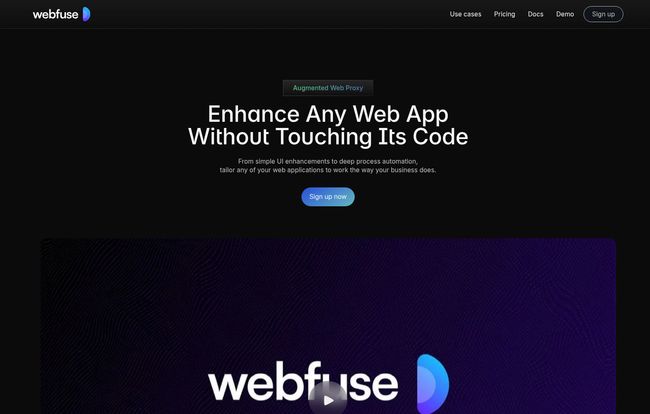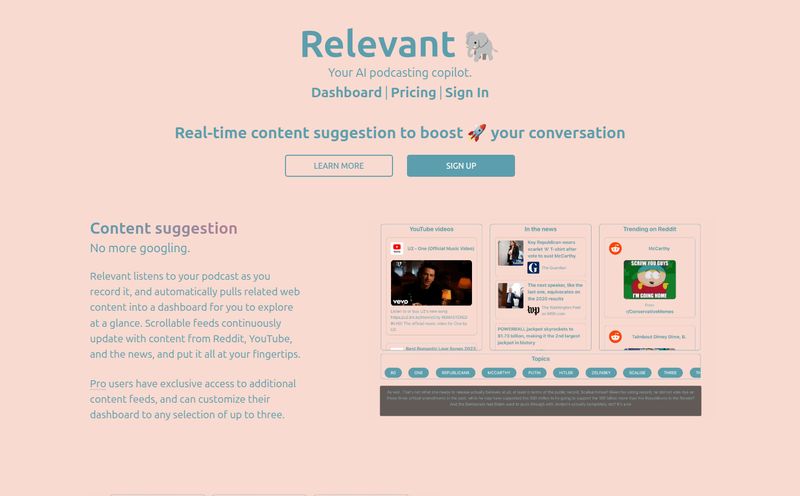Let’s have a little heart-to-heart. How many times have you, as a marketer, SEO, or even a product manager, had a brilliant idea for a simple website tweak... only to be told by the dev team that it's a six-week sprint away? You just want to add a banner, test a new call-to-action, or guide users through a confusing checkout flow on a third-party app. But you’re stuck. It's the classic roadblock. The one that makes you want to tear your hair out.
I’ve been in that trench for years. We fight for traffic, we optimize for conversions, and sometimes the biggest battle is just getting a tiny change pushed live. The dependency on development resources for marketing-led initiatives is a constant, nagging friction point. So when a tool comes along that claims to let you “Enhance Any Web App Without Touching Its Code,” my ears perk up. But my skepticism meter also goes into overdrive.
The tool in question is Webfuse. It calls itself a “web augmentation platform.” And after spending some time digging into it, I think it might be one of the most interesting pieces of tech I’ve seen this year. It's not just another WYSIWYG editor or a glorified browser extension. It’s something… different.
So, What is Webfuse, Anyway?
Imagine you have a website. Now, imagine laying a perfectly clear, interactive sheet of glass over it. This sheet of glass is Webfuse. You can draw on it, add buttons, create pop-ups, and even build automated guided tours—all without leaving a single mark on the original website underneath. This is the essence of web augmentation.
Webfuse creates a secure middleware layer that sits between your user and the web application they’re interacting with. This isn’t about changing your site's source code. In fact, that's the whole point—you don't need access to it. You can augment your own site, a partner’s site, or even a SaaS tool you use daily. Think of it like Google Tag Manager on steroids, with a dash of real-time collaboration and a heavy dose of enterprise-level security. It's a pretty bold proposition.

Visit Webfuse
The Big Problems Webfuse Aims to Solve
The homepage of Webfuse immediately calls out the pains we all know too well: lack of resources, risky live deployments, and limited customization options, especially on third-party platforms. It’s a direct shot at the bottlenecks that stifle innovation.
I remember a client project a couple of years back where we desperately needed to add a custom support widget to a third-party booking platform we were integrated with. It was technically impossible. We couldn't touch their code. We ended up building a clunky workaround involving browser extensions that had to be manually installed by every user. It was a mess. A tool like Webfuse would have turned that multi-week nightmare into an afternoon project. Let that sink in for a moment.
This is for the teams that need to:
- Rapidly prototype new features on a live site without breaking anything.
- Onboard new users with interactive, in-app guides.
- Automate repetitive tasks across different web applications.
- Securely share and audit web sessions for compliance or training.
How Does It All Work? The Magic Layer Explained
The secret sauce is the “Virtual Web Session.” When a user session is initiated through Webfuse, the platform essentially creates a sandboxed instance of the web experience. Within this sandbox, you have the power to inject your own custom HTML, CSS, and JavaScript. You can modify the interface, automate clicks, and extract data in real-time. The original application remains completely untouched and unaware.
This is a huge deal. It means you can build functionality on top of platforms you don’t own. Want to create a unified dashboard that pulls data from your Google Analytics, your Salesforce, and your project management tool? You could potentially build a Webfuse layer that does just that, creating a seamless experience for your team without a single API integration. It's a fundamental shift from building new things to enhancing the ones that already exist.
My Favorite Webfuse Features for Marketers and Developers
Okay, let's get into the good stuff. The features that made me go, “Oh, that’s clever.”
No-Code Prototyping and Customization
This is the most immediate and obvious benefit. The ability to visually edit a webpage, add components, and change the user flow without writing a line of code is powerful. For A/B testing, this is incredible. You don't need to set up complex experiments in Google Optimize (RIP) or VWO that might slow down your site. You can just create two different augmented versions and direct traffic accordingly. It’s faster, cleaner, and doesn’t mess with your core code.
AI Automation That's Actually Useful
The term “AI” gets slapped on everything these days, but the application here feels practical. Webfuse allows you to build automation workflows that can perform tasks on a website just like a human would. Think data entry, report generation, or testing user journeys. Because it interacts with the front-end, it can often bypass the need for complex and brittle API scripts. It’s a more resilient form of robotic process automation (RPA) designed specifically for the web.
Real-Time Collaboration and Session Sharing
This is a feature I didn’t expect but now can’t stop thinking about. You can share a web session with a colleague, and you both can interact with the page simultaneously. For support teams, this is amazing. You can literally take control and show a customer exactly where to click. For user acceptance testing (UAT), multiple stakeholders can be in the same session, pointing out issues and seeing changes made live. It’s like Figma for live websites. It turns a static experience into a multiplayer one.
Security That's Not Just an Afterthought
Running scripts on top of websites sounds... sketchy, right? My first thought was, “What about security?” Webfuse seems to have put a lot of thought into this. They mention enterprise-grade security, GDPR, HIPAA, and ISO compliance. The platform itself provides a secure, auditable environment. Every action can be logged and reviewed. This is critical for industries like finance and healthcare, where compliance is non-negotiable. They even have features like “Cookie Guard” and “Content Masking” on their higher-tier plans, which shows a deep understanding of enterprise security needs.
Let's Talk About Webfuse Pricing
Alright, the all-important question: what does this cost? The pricing page lays it out pretty clearly. It's a mix of a monthly subscription and a usage-based model, which is interesting. The usage is priced at €0.0004 per virtual session minute. This kind of pay-as-you-go model can be really cost-effective for smaller projects or infrequent use, but you’d need to do the math for high-traffic applications.
Here’s a quick breakdown of their monthly plans:
| Plan | Price | Key Features |
|---|---|---|
| Spark | €19 / month | Webfuse Studio, JS API, Magic Links, Extension API |
| Flare | €239 / month | Everything in Spark + Custom Storage, Audit Logs, Recordings |
| Forge (Most Popular) | €529 / month | Everything in Flare + Automation, Screenshots, Session Sharing, Remote Control |
| Foundry | Talk to sales | Everything in Forge + Advanced Security, Cookie Guard, SSO, SLA |
The jump from Spark to Flare is significant, but it's where you get the crucial audit and recording features. Forge seems to be the sweet spot for teams wanting to lean heavily into automation and collaboration. Foundry is clearly for the big players with strict security and compliance requirements.
The Potential Downsides: A Reality Check
No tool is perfect. While I’m genuinely excited about Webfuse, there are a few things to consider. First, there's going to be a learning curve. It’s “no-code” in that you don’t need to be a developer, but you will need to learn the Webfuse way of doing things. It's a powerful platform, and with power comes some complexity.
Second, you are creating a dependency on their platform. If you build a critical user onboarding flow with Webfuse and then decide to stop using it, that flow disappears. It's the nature of any SaaS tool, but something to be aware of. You're not modifying your site; you're renting an enhancement layer for it.
Final Thoughts: Is Webfuse a Game-Changer?
So, is Webfuse the magic wand we’ve all been waiting for? Maybe. It's not going to replace your development team, nor should it. But it has the potential to completely unblock them.
For marketing and product teams that are constantly fighting for resources, Webfuse isn't just a tool; it's a release valve. It empowers the people with the ideas to actually execute them, safely and quickly. The ability to enhance, automate, and collaborate on any web application without touching the source code is, in my opinion, a very big deal. It won't be for every company or every project, but for the right use case? It could be one of the best investments you make in your tech stack. I'm definitely keeping a close eye on this one.
Frequently Asked Questions about Webfuse
1. How does Webfuse affect my website's SEO?
This is a great question for any SEO. Since Webfuse operates as a middleware layer and doesn't alter your site's source code, it shouldn't directly impact your on-page SEO factors that Googlebot crawls. The changes are applied within a user's virtual session. However, you should be mindful of how you use it. If you use it to create a better user experience, that could indirectly lead to better engagement signals (like lower bounce rate and higher time on page), which are positive for SEO. Conversely, if you create a clunky or slow augmented experience, that could hurt user metrics.
2. Can I really use this on any website, even ones I don't own?
Yes, that's one of the core value propositions. You can use it to create overlays or automation for internal tools, SaaS platforms like Salesforce or HubSpot, or partner websites. This is particularly powerful for creating custom training modules or automating tasks across platforms that dont have native integrations.
3. Is Webfuse secure enough for sensitive data?
Based on their documentation and features, they take security very seriously. With mentions of GDPR, HIPAA, ISO, and features like Content Masking, SSO, and Audit Logs in their enterprise-tier plan, it's built with security in mind. The platform creates a secure, isolated session. However, as with any tool, you should perform your own security due diligence, especially if you operate in a highly regulated industry.
4. Is this just a fancy browser extension?
No, and this is an important distinction. While there is an extension API, the core platform is a cloud-based middleware. A browser extension runs locally on a user's machine and can be inconsistent. Webfuse orchestrates the experience from a centralized, secure platform, ensuring consistency, security, and auditability across all users you grant access to.
5. Do I need to be a developer to use Webfuse?
Not necessarily. The platform is designed with a no-code/low-code approach, featuring a visual editor (“Webfuse Studio”). A tech-savvy marketer or product manager should be able to handle many tasks. However, to unlock its full potential, especially with the JS API for complex customizations, some basic knowledge of web technologies (HTML, CSS, JavaScript) will be a significant advantage.
Reference and Sources
- Webfuse Official Website
- Webfuse Pricing Page
- Forbes Article on the No-Code Movement
- Cloudflare on Web Application Security



